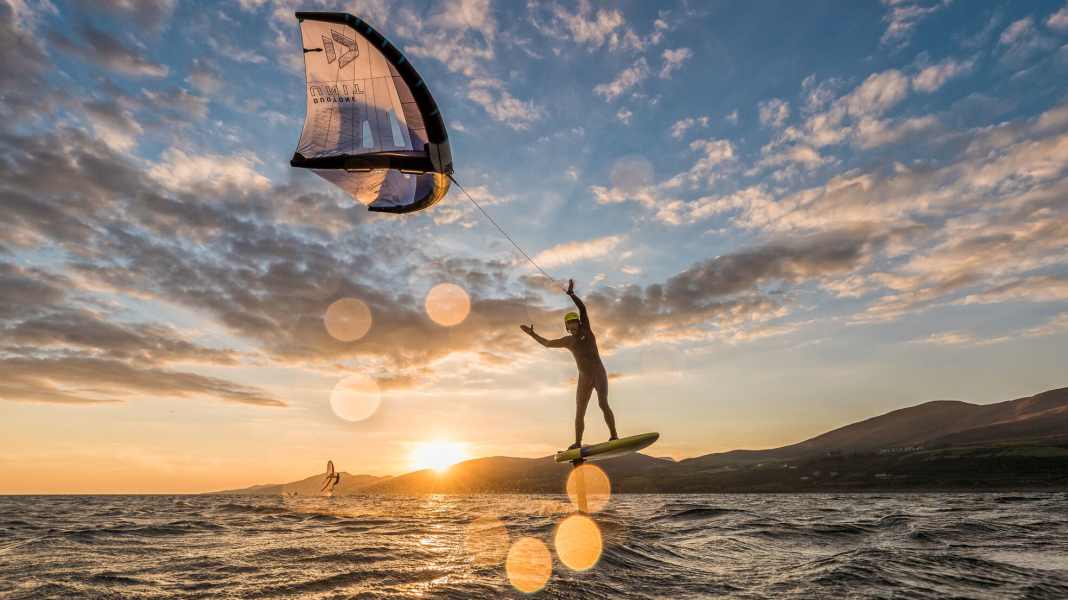
She's quite annoying at first. But at some point it turns out that it's okay and it's good to have it. We're talking about the leash, of course, which many wingsurfers initially enter into a forced marriage with, but then come to terms with quite well. The following couple's advice will tell you which leash you should enter into a lifelong relationship with - and when a permanent separation might be the better decision after all.
The right wing leash
A secure connection between the surfer and the wing is essential. Once released, the wing would otherwise disappear never to be seen again, with no chance of ever catching up with it while swimming or paddling.
Most wings are supplied with a suitable hand leash, which is tied to the front tube of the wing and usually attached to the wrist. In practice, it doesn't matter which hand you attach the leash to, as you change hands when turning round anyway, which means that the leash is sometimes attached to the front hand and sometimes to the back hand. Particularly at the beginning, the leash often gets in the way of manoeuvres because it gets wrapped around your wrist, for example. To fix this, you have to release the corresponding hand for a brief moment after the manoeuvre and "untwist" the leash - not a problem for experienced wingsurfers, but sometimes annoying when learning.
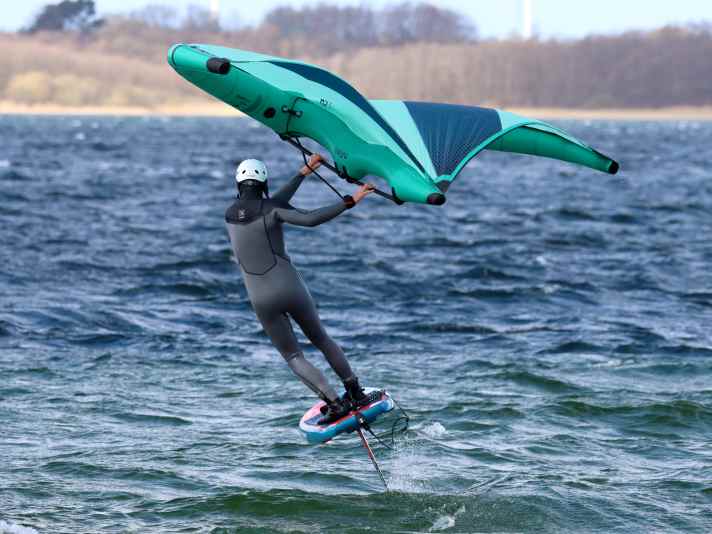
Another option for those who like to have their hands free is the hip leash. Here, the leash is hooked onto a hip belt. The advantage: you have your hands free and don't get tangled up in manoeuvres. However, under certain circumstances, the leash can get caught on the foil or board when swimming in the water or climbing up - which is not everyone's cup of tea.
There is also the question of whether to use a smooth or coiled (uncoiled) leash. Those in favour of the smooth version argue that you almost forget about the smooth versions as they are somewhat lighter. The disadvantage: they wrap around the wrist more easily. But coiled leashes also have advantages and disadvantages: There is less risk of tangling, but the twisted version is much bulkier and sometimes gets in the way. Which system you ultimately choose on the wing is therefore a matter of taste and not a question of right or wrong.
The right length of leash
The question of the right length remains: in general, the leash to the wing should be long enough so that you can swim around the wing tip.
Rule of thumb for handleashes: Length of the leash = half the wing span
An average five-square-metre wing has a wingspan of around 340 centimetres. A five-foot leash with some stretch is therefore usually ideal, but for very large wings (> 6 square metres) with a correspondingly larger wingspan, a six-foot leash can also make sense. Freestylers, who often use small wings of less than five square metres, also like to use shorter leashes with a length of four to five feet so that they don't hit too hard during jumps and rotations.
And how tight should the leash be on your wrist? Only so tight that it can still turn round the wrist. And never so loose that it slips over your hand. In addition, the looser it is fastened, the less the Velcro overlaps. If the wing suddenly tears, the Velcro fastener can come undone and the wing disappears into the horizon.
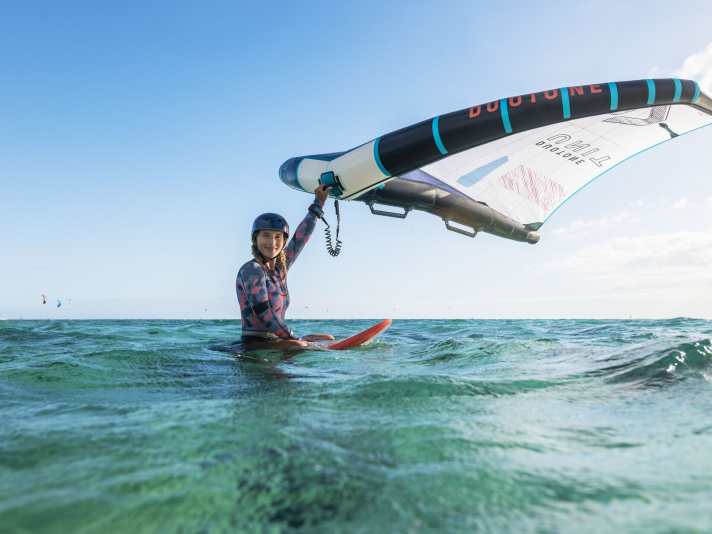
The right leash for your board
A board leash is standard equipment for beginners and intermediates. You can find out what is important here below.
Foot or hip leash - which connection to the board makes sense?
A leash is not normally included with wingsurf boards - it has to be purchased separately. Again, there are two options: The foot leash is the most common and is attached to the ankle. Here too, the right length is crucial. If the leash is too long, it drags annoyingly in the water. If it is too short, there is a risk of injury because you cannot get far enough away from the board if you fall.
Rule of thumb for foot leashes: Length of the leash = board length
A good tip for the connection to the board are generally coiled leashes. These are shorter when untwisted and don't drag as much in the water. However, newcomers to wingsurfing in particular are often bothered by the fact that foot leashes often become a tripping hazard or get caught between the foot and the strap. In this case, the hip leash is a sensible alternative.
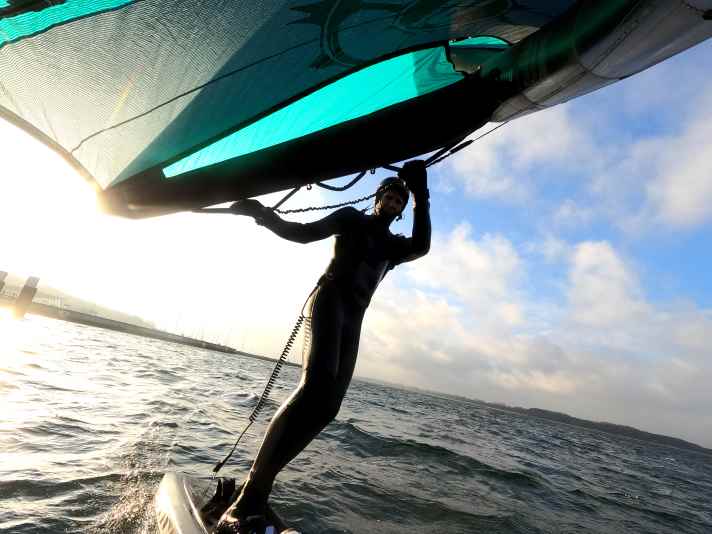
The waist leash consists of a normal coiled leash that is hooked onto a special waist belt ("Wingsurf Waist Belt"), which means that the leash no longer becomes a tripping hazard when lying on the board. The annoying dragging of the leash in the water is also a thing of the past. A suitable coiled leash for use with a waist belt measures 4-5 feet - when stretched, the leash then stretches out to 8-10 feet. However, the twisted version also has its downsides: When swimming next to the board, you often have the leash between your legs. It can also wrap around your hips and legs. Hence our tip: The waist belt should not sit tightly around your body. Once the leash is wrapped around your hips, you can simply twist the strap and untie it.
Into the wave and into the air without a leash
In certain cases, you can do without the connection to the board as a wingfoiler, e.g. for ambitious freestyle tricks or in the waves. Anyone practising front and back flips or travelling in powerful surf wants to be able to move away from the board (and the sharp foil) in a controlled manner. Freestyle pro Balz Müller: "For the first attempts at wingfoiling, the leash is indispensable and, depending on the conditions, it is also negligent for professionals to go out on the water without a leash, as you will never be able to keep up with your board in strong winds. But from the moment you plan to jump overhead manoeuvres with the wing, such as front or back flips, I advise you not to use a leash because otherwise your board will be thrown back like a boomerang and you could injure yourself. However, the prerequisite is that you surf with someone who can look after your board."
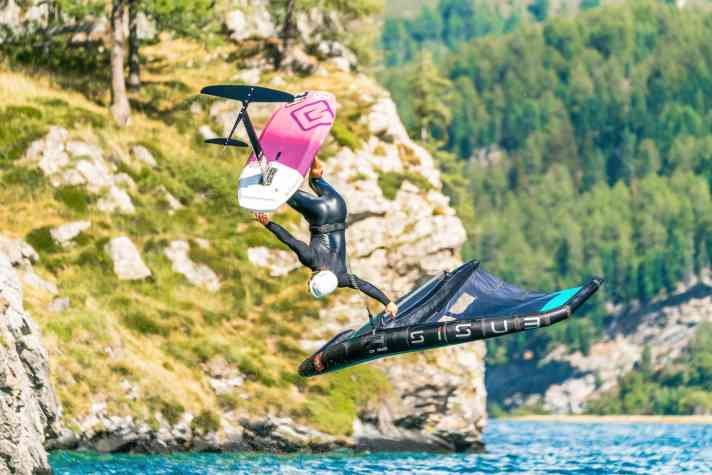
Conclusion:
Tip for Wing beginners:
- Handleash to wing with 5-6 feet length
- Waist belt with coiled leash as connection to the board; length (stretched) approx. 8-11 feet
Tip for experienced wingsurfers:
- System selection according to personal preference
- Length of foot leash = board length; alternatively hip belt with coiled leash (stretched) 8-11 feet
Tip for freestyle and waves:
- As soon as front or back flips are on the programme, a leash can be dispensed with
- The prerequisite is that fellow travellers can secure the board in an emergency and that drifting is ruled out
Also interesting:

